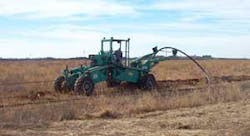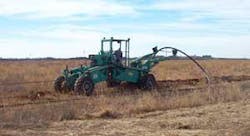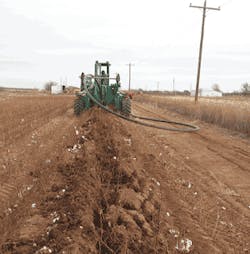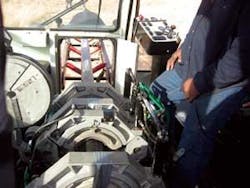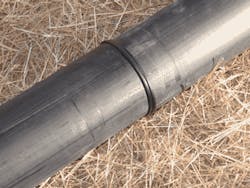Companies Team to Help Rural Residents in Need
When the rural residents of Dickens County, Texas, who are served by the Valley Water Supply Corp. (VWSC), were faced with the obstacle of a rapidly deteriorating water distribution system, a civil and environmental engineering firm based in West Texas stepped in to find a solution that involved use of a new pipeline installation process.
The VWSC, located north of Spur, TX, received funding through the Texas Small Towns Environment Program (STEP) to install 42,600 linear feet of 4-inch DR-11 HDPE water line to replace existing plastic water lines that were over 35 years old and leaking badly. The water loss rate at VWSC had exceeded 65 percent – with only 700,000 gallons used out of over 2 million gallons of water pumped through the system.
The engineering firm Enprotec/Hibbs & Todd, Inc. (eHT) provided VWSC with engineering services and teamed up with SpiderPlow Services, a specialized pipeline installation company that primarily operates in western Canada and the U.S., as well as ISCO Industries, the largest distributor of HDPE pipe, fittings and fusion equipment in North America, to offer a faster and more efficient pipeline installation.
Because the STEP fund requires volunteer effort to do the work, eHT, SpiderPlow and ISCO worked together to provide this service to help the rural residents of Dickens County.
“ISCO and SpiderPlow made this project happen. Realistically, if the Water Supply Corporation had relied on their own residents to get the project done, it would have taken 18 months to two years, working weeknights and weekends. We accomplished this project in two weeks,” said John Voller, Construction Manager and Inspector for eHT. “It also would have cost a fortune using conventional methods. This approach saved the WSC time and money and gave them a tighter system.”
This project represented a Texas debut for the SpiderPlow, which involves use of a plow that can cut a trench up to eight feet deep in a single pass.
“The project in Spur was not only an ideal opportunity to showcase the SpiderPlow, but it was also the right thing to do,” said Brian Bonner, Vice President and General Manager of SpiderPlow. “That is why when we were approached by eHT about helping out the community, we were happy to work within the project scope and budget.”
The system uses a specially designed all-terrain, all-weather mobile winch vehicle (Winch Crawler) that pulls the German-engineered SpiderPlow forward by a cable. Because it is anchored into the ground, the Winch Crawler avoids the churning and mixing together of top soils often associated with tracked or wheeled vehicles struggling for traction.
The unique ripper and chute design of the plow displaces the soil, settling the ditch bottom with its own weight. The tip of the plow blade forms and clears the laying bed at specific depths to over eight feet. Then, using a patented guidance system, a pipe insertion unit is dragged along the bed and the pipe is inserted into the cavity.
On a good day, the winch-plow team can cover four miles with only a three-person crew. Unlike traditional excavating, which requires a team of track hoes and a bulldozer to make room for infrastructure and a follow-up crew to backfill, clean up and fix a scarred landscape, the SpiderPlow leaves a narrow mound of earth in its wake with a furrow in the center. In some places, the furrow is hardly noticeable and there’s no lasting damage because the grass root structure stays intact.
While being primarily focused on the oil and gas industry, the SpiderPlow team is now expanding its market to include water lines, long haul fiber optic cable, as well as electrical cable for wind farms. The pipe laying system has the ability to install as many as 40 one-inch lines at the same time.
The HDPE pipe used for the new system has welded joints every 50 feet that create a continuous run of water line for over eight miles. ISCO’s Fast Fusion™ technology sped up the welding process and improved quality control. Each weld was computerized and logged, and the temperature control was documented.
ISCO’s Mobile Fusion Trac-20 was used on the project. It is a tracked, self-contained fusion apparatus that provides a climate controlled environment in which to make the pipe fusion joint for pipe sizes 2 inch to 20 inch. The vehicle’s leading “boom” lifts a joint of pipe off the ground and the forward progression of the vehicle propels the pipe into the cab of the machine. Two joints of pipe are loaded and clamped into a fusion apparatus in-line with the pipe right-of-way. Once the onboard PLC unit notifies the operator the fusion is complete, the MFT-20 tracks forward to the next joint of pipe while the fused string exits the rear of the vehicle. The result is a leak-free fused pipeline ready for installation.
“This approach is underutilized, we believe, in the water environment,” said Scott Hay, Vice President of eHT. “Typically, HDPE pipe is slightly more expensive and most systems aren’t set up for tapping and adding on. Once we highlighted to VWSC all of the advantages in using HDPE materials with tapping equipment and repair fittings that are easier to use, they felt comfortable making the transition.”
eHT felt that the project was a tremendous success. The company’s staff was involved every step of the way. They got approval of the STEP funds, completed design, received approval through the TCEQ, worked with SpiderPlow, ISCO and VWSC in coordinating applications, and provided construction management, overseeing the team as they laid eight miles of pipe in 16 hours. ISCO’s Fast Fusion™ averaged five to seven minutes per weld and SpiderPlow laid one-half mile per hour on average.
“We’d never seen anything like this technology before and it was very impressive. We weren’t sure if we were going to be able to pull this off, but with the help of eHT, SpiderPlow and ISCO, the project was a huge success,” said Brice Capps, President of the VWSC.
